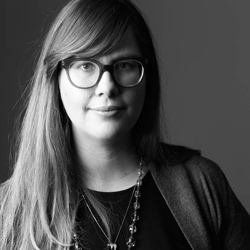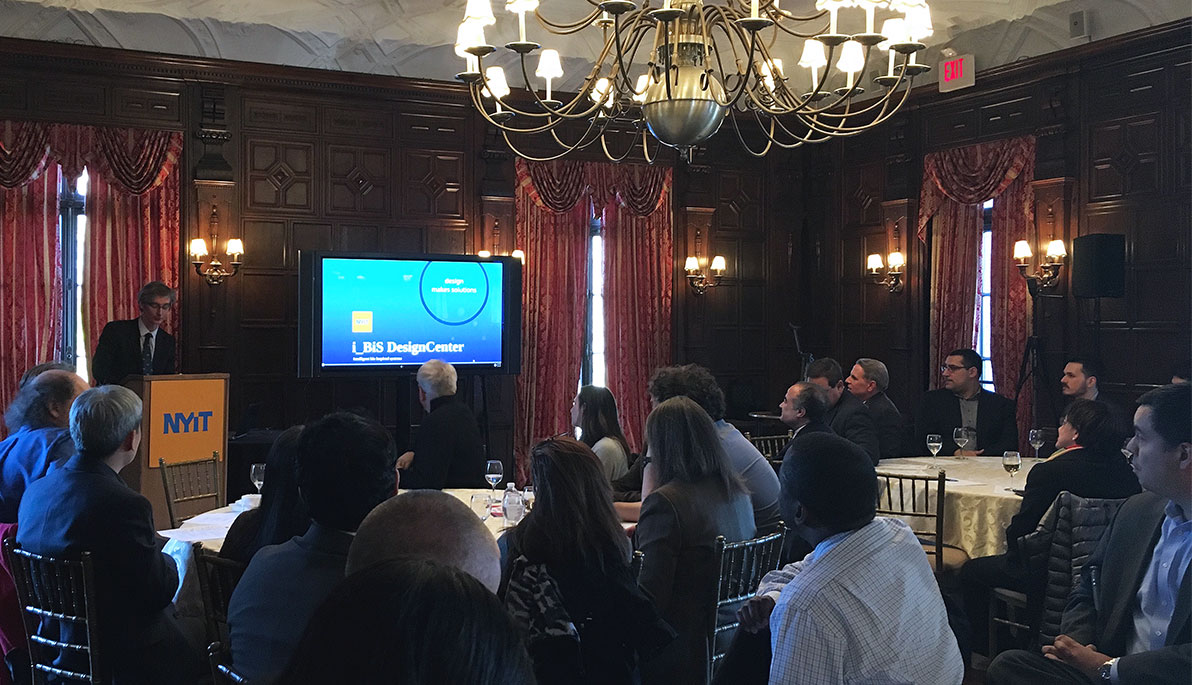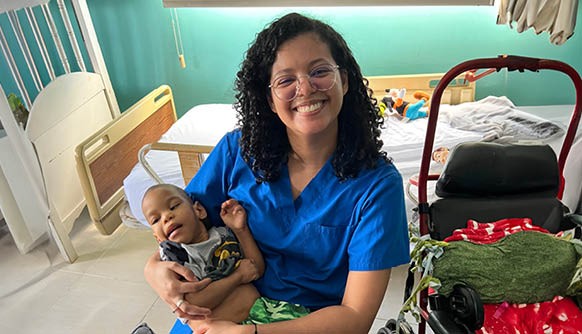News
Centers at the Center of Cross-Disciplinary Networking Event
March 14, 2017
Photo: Christian Pongratz, professor of Interdisciplinary Studies, discusses the Center for Intelligent Bio-Inspired Systems.
At a faculty networking event in early March, members of the NYIT community were introduced to three exciting new interdisciplinary centers, which will be housed on the Old Westbury campus. The Cross-Disciplinary Research Centers for Cybersecurity and Privacy, Bio-Inspired Systems, and Visualization and Digital Entertainment offer more ways than ever for faculty members and students to work across fields of study and to collaborate with industry leaders in corporate, nonprofit, and government organizations who can join as partners.
Interim President Rahmat Shoureshi, Ph.D., introduced the event. “I’m delighted to see that all of this is coming together,” he said after recognizing center leaders and industry partners already on board. Members will work together to solve pressing issues of today—and tomorrow—and provide meaningful, real-world research opportunities to students. “Whether it’s technology, science, art, or creativity—it’s one of the most effective mechanisms of achieving those goals,” said Shoureshi. “But more importantly, it’s part of really improving and enhancing the quality of education that we provide our students.”
Following his introduction, faculty members and industry partners spoke about the mission and goals for each area. Then, the audience separated into breakout sessions, where they brainstormed ideas, saw additional presentations, and explored more ways to be collaborative.
Associate Professor for Architecture and Interior Design Charles Matz spoke first about the visualization and digital entertainment center, which is focused on data visualization with a strong emphasis on its application in education and entertainment, as well as architecture, engineering, and construction. “The vision is to be a hub or crucible of activity where NYIT becomes a universe where these activities can revolve around, and to bring responsible parties to the table who can provide resources,” said Matz. He was joined by Matthew Cornelius, art media technical director in the College of Arts and Sciences, and industry partner Christopher D’Andrea, a 3-D and motion graphics designer for BBDO Worldwide and Mythic VR.
Next, Assistant Professors Kiran Balagani and Paolo Gasti of the School of Engineering and Computing Sciences spoke about the cybersecurity center, which will focus on areas including privacy and mobile security, transportations systems, social networks, and more. Gasti said they see the center as a promising way to leverage faculty and partner support and collaboration and a way to secure and grow research and infrastructure. Joining them was Michael Nizich, director of NYIT’s Entrepreneurship and Technology Innovation Center, and James Ogletree, director of cybersecurity and IT services at Northrop Grumman. Ogletree spoke about the wide range of cyberattacks that occur today, many of which can be easily deployed, and the need for qualified engineers in the field. “As our CEO says, our most valuable resource are our current employees and our future employees. We can’t hire enough people in this field right now…It’s really a matter of training students and future employees in the skillset and getting them employed.”
Lastly, Professor of Interdisciplinary Studies Christian Pongratz discussed the bio-inspired systems center, which is fueled by research in advanced material technologies, nano- and micro-devices, digital fabrication, and tool making. Using design principles found in nature, collaborators (including faculty members, students, and industry partners) will find ways to apply these design principles toward discovering novel, transformative engineering strategies across disciplines and then translate those solutions into new products and solutions. In the breakout session, Pongratz invited Ken Gilson and other employees from robotics company Haddington Dynamics to demonstrate their 5-axis robot. After the demo of the versatile and relatively low-cost robot, the group discussed ways the machine could be useful in research at NYIT and even abroad in the area of global health. Christopher Fry of MIT and Jonathan Tibett of Precision Stone, a company that uses high-definition 3-D scanning and digital modeling to create stonework, also spoke at the event.
Though the centers are still in their early stages, faculty members and partners can already find ways to collaborate and take advantage of unique cross-disciplinary opportunities. “There’s a synthetic process where we put together people who you may not have imagined would go together,” said Matz. As for outcomes, success depends on the person. “To different parties, it means different things. We want educational outcomes and research and growth for the institution. In the case of an industrial or commercial partner, they also have to get something for their participation.” That, said Matz, could mean communications or marketing or the opportunity to come to the table and brainstorm ideas, but above all, he says, “the most important thing they can get from that relationship is access to the intellectual brains in this institution.”
Faculty members who are already participating and lending their advice include: N. Sertac Artan, Kiran Balagani, Brian Beatty, Houwei Cao, Dorinamaria Carka, Matthew Cornelius, Babak Dastgheib-Beheshti, Ziqian Dong, Aydin Farajidavar, Mathew Ford, Naomi Frangos, Paolo Gasti , Jonathan Geisler , Huanying Gu, Michael Hosenfeld , Azhar Ilyas , Fang Li, Wenjia Li, Charles Matz, Gavin McStay, Terry Nauheim Goodman, Michael Nizich, Christian Pongratz, Raddy Ramos, Anand Santhanakrishnan, Stan Silverman, Robert Smith, Jason Van Nest, Aleksandr Vasilyev, Jonathan Voris, Sabiha Wadoo, and Shiang-Kwei Wang.

By Julie Godsoe




